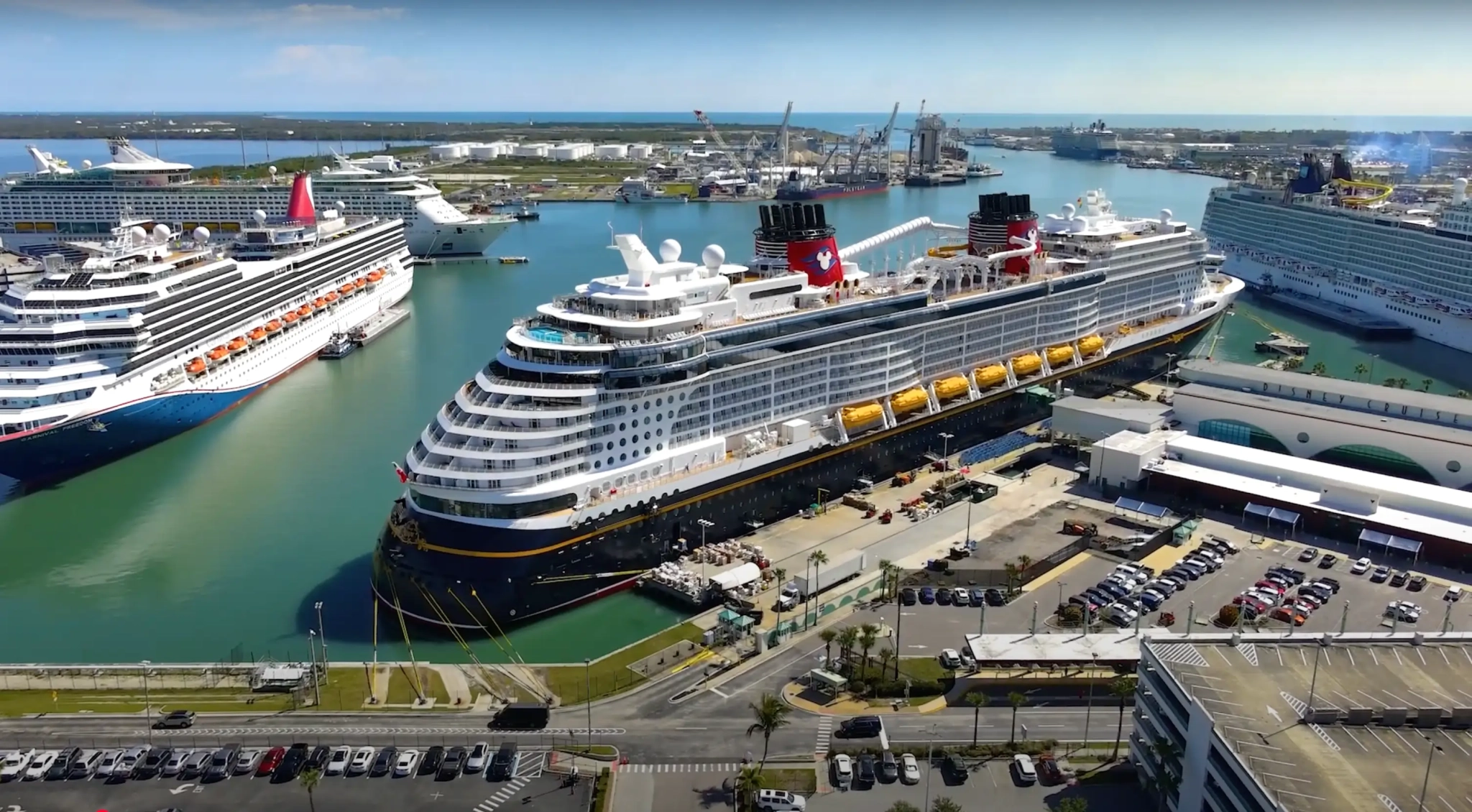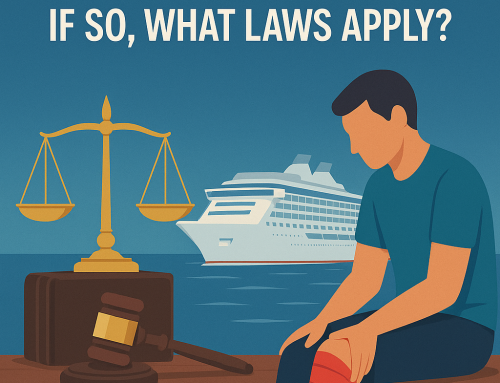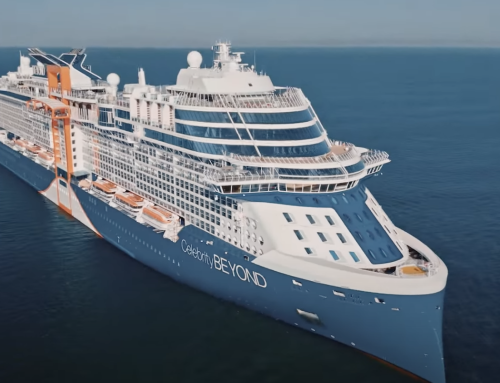By Cruise Ship Injury Attorney Alex Perkins, Esq. Perkins Personal Injury Lawyers.
When you sue a cruise line for a personal injury or accident that occurred during a cruise voyage, if that cruise touched a US port, the personal injury lawsuit must be brought in federal court in the United States. More specifically, most cruise lines have terms and conditions in their ticket contracts that require all lawsuits against them be filed in the United States District Court for the Southern District of Florida, which is located in Miami. This is true for many of the major cruise lines like Royal Caribbean International, Norwegian Cruise Line, Celebrity Cruises, Regent Seven Seas, Princess Cruises and Carnival Cruise Lines, Virgin Cruises. It didn’t always use to be this way. Previously, you could sue in state court in Florida in Miami-Dade County because the ticket contracts allowed for it. But not anymore. All of the big boy cruise lines got on the same page and have venue and forum selection clauses in their contract’s terms and conditions. In other words they make you enter into a contract when you purchase your ticket that if you do get hurt, all such lawsuits would have to be filed in federal court.
Not too long ago, there was a bit of a gray area as to whether you could still file some lawsuits related to a cruise in state court if they did not actually happen on the cruise ship and occurred stateside. Cruise ship injury lawyers filed some incidents in Miami-Dade County Circuit Court (state court). But not anymore. The Courts have spoken. Passengers heading out or heading home on a cruise can get injured anywhere. They can get injured on the ship, during an excursion or getting on or off the ship. We typically refer to this as ingress or egress. I like to think of the duty of the cruise line is to make sure they act reasonably to get their passengers safely from ship to shore and vice versa. Therefore, this would include incidents like slip and falls on gangways, tender boats ferrying passengers back-and-forth from the pier, and even sexual assaults that happened in the shadow of the ship.

Can You Sue the Cruise Line for Injuries That Happened at the Port?
Why Cruise Terminal Injuries Must Be Filed in Federal Court Under Admiralty Law
The courts have extended this federal admiralty jurisdiction to incidents that happen off of the ship in the cruise terminal. For example, when someone trips and falls on a loose and unlevel metal threshold breaking their nose in a cruise terminal while getting ready to board the ship or disembark the ship, the courts have required those cases be brought in federal court rather than in state court. There have been some cases where people that are injured at a port terminal have attempted to avoid admiralty jurisdiction and federal court by filing suit in state court where the port is. The idea was that since the incident happened on land before the cruise took off, or upon their return home when the cruise was over, the injured party should not have to be governed by the cruise line ticket anymore. Well, those cases were bounced from state court because the federal courts have determined federal admiralty jurisdiction does extend to cruise terminal cases based on the location and connectivity test.
Below is an in the weeds discussion from a case having to do with requiring the injured passengers to file suit in federal court for incidents that occur on land in the cruise terminal, resulting in their cases getting dismissed from state court. The law is now that the terms and conditions of the ticket contract still govern incidents that are connected to the cruise, even though they may happen on land. Therefore, the venue and forum selection clauses are upheld still requiring cruise ship injury cases that happen in the cruise terminal or port to be filed in federal court.
Carnival Cruises v. Garcia
A federal court’s authority to hear cases in admiralty flows initially from the United States Constitution, which “ ‘extend[s]’ federal judicial power’ to all Cases of admiralty and maritime Jurisdiction.’ ” Jerome B. Grubart v. Great Lakes Dredge & Dock Co., 513 U.S. 527, 531, 115 S.Ct. 1043, 130 L.Ed.2d 1024 (1995) (alteration in original) (citing U.S. Const., Art. III, § 2). Section 1333 prescribes: “The district courts shall *1114 have original jurisdiction, exclusive of the courts of the States, of: (1) Any civil case of admiralty or maritime jurisdiction, saving to suitors in all cases all other remedies to which they are otherwise entitled.” 28 U.S.C. § 1333(1).
The mandatory forum selection clause contained in the ticket contract applies to “all disputes… incident to this Contract or the Guest’s cruise, including travel to and from the vessel” and provides for venue in the United States District Court for the Southern District of Florida in Miami for those lawsuits over which the federal court has subject matter jurisdiction. See, e.g., Carnival Cruise Lines v. Shute, 499 U.S. 585, 111 S.Ct. 1522, 113 L.Ed.2d 622 (1991) (finding a forum selection clause in a commercial cruise ticket contract enforceable); Carnival Corp. v. Booth, 946 So.2d 1112 (Fla. 3d DCA 2006) (enforcing a forum selection clause identical to the one in the present appeal); Leslie v. Carnival, 22 So.3d 561 (Fla. 3d DCA 2008) (enforcing a nearly identical forum selection clause as the one in the instant appeal), aff’d by an equally divided court en banc, 22 So.3d 567 (Fla. 3d DCA 2009), rev. denied, 44 So.3d 1178 (Fla. 2010), cert. denied, 562 U.S. 1270, 131 S.Ct. 1603, 179 L.Ed.2d 499 (2011). Thus, it follows that only in the absence of admiralty jurisdiction, will proper venue lie in a state court in Miami–Dade County.
Federal vs. State Court: Jurisdiction Battle in Cruise Terminal Injury Cases
The issue before us, then, is whether the federal court or the state court has subject matter jurisdiction. Carnival contends that our recent decision in Newell, and the cases on which we relied therein, compels reversal and dismissal.3 180 So.3d 178. In response, Garcia contends Newell does not apply because the injury here occurred prior to embarkation and seeks affirmance based on Fernandez v. Ceres Marine Terminals, Inc., 2013 WL 1663333, at *1, 2013 U.S. Dist. LEXIS 54992, at *1 (M.D. Fla. Apr. 17 2013) and Vincenzo v. Carnival Corp., 2012 WL 1428888, at *1, 2012 U.S. Dist. LEXIS 57040, at *1 (S.D. Fla. Apr. 24, 2012).4
In Newell, a passenger who had just completed a Carnival cruise alleged she was injured in the Port of Miami after exiting the ship when she fell over a metal stand located on a pathway between the luggage claim area and the United States Customs station. 180 So.3d at 179. The passenger sued Carnival in state court in Miami–Dade County alleging that Carnival negligently maintained or created the walkway by its placement of the metal stands. Id. at 179–80. The ticket contract between Carnival and the passenger contained a forum selection clause requiring that any prospective claims “arising under, in connection with or incident to [the ticket contract] … including travel to and from the vessel, shall be litigated, if at all, in the United States District Court for the Southern District of Florida.” Id. at 180 (alteration in original). The ticket contract further provided if the federal court lacked subject matter jurisdiction, then the lawsuit must be filed in a state court located in Miami–Dade County.
Id. We framed the issue in Newell as “whether admiralty jurisdiction exists when a cruise ship passenger alleges that, as a result of the negligence of the cruise line, she was injured *1115 after exiting the ship and while walking in a restricted area of the cruise ship terminal on her way to the United States Customs station.” In answering the question in the positive, we found both the location and connectivity tests were met. Id. at 180–81, 183.
Falling Outside Federal Jurisdiction: Cruise Terminal Cases That Don’t Qualify Under Maritime Law
In Fernandez, on which Garcia relies, a plaintiff sued Ceres Marine Terminal, Inc. (“Ceres Marine”) in state court for injuries allegedly sustained when she fell on the roadway in front of the Tampa port terminal. 2013 WL 1663333, at *2–3, 2013 U.S. Dist. LEXIS 54992, at *7. The plaintiff had a ticket for a cruise with Carnival Cruise Line, scheduled to depart from that port. Id. at *2, 2013 U.S. Dist. LEXIS 54992, at *6. At the time of injury, the plaintiff had stopped her car in the front of the terminal to drop off her luggage before parking to embark on the cruise. Id. at *2–3, 2013 U.S. Dist. LEXIS 54992, at *6–7. Ceres Marine removed the case to federal court and the United States District Court for the Middle District of Florida remanded the case back to state court upon finding there was no basis to exercise admiralty jurisdiction. Id. at *1, 3, 2013 U.S. Dist. LEXIS 54992, at *1, 8. In so doing, the District Court concluded that the locality test had not been met because the incident occurred entirely on land and not on navigable waters and was not caused by a vessel on navigable waters. Id. at *3, 2013 U.S. Dist. LEXIS 54992, at *8.
Similarly, in Vincenzo, on which Garcia also relied, the United States District Court for the Southern District of Florida dismissed a plaintiff’s claim for negligence against Carnival Corporation for lack of admiralty jurisdiction because the location test had not been met, where a cruise ship passenger tripped and fell while stepping down a large step while exiting the port area of the terminal after departing the ship. 2012 WL 1428888, at *1, 2, 2012 U.S. Dist. LEXIS 57040, at *1–2, 5.
Pursuant to the Extension of Admiralty Jurisdiction Act “[t]he admiralty and maritime jurisdiction of the United States extends to and includes cases of damage or injury, to person or property, caused by a vessel on navigable water, even though the injury or damage is done or consummated on land.” 46 U.S.C. App. § 30101(a)).5 In determining whether admiralty jurisdiction exists, the United States Supreme Court has held:
[A] party seeking to invoke federal admiralty jurisdiction pursuant to 28 U.S.C. § 1333(1) over a tort claim must satisfy conditions both of location and of connection with maritime activity. A court applying the location test must determine whether the tort occurred on navigable water or whether injury suffered on land was caused by a vessel on navigable water. The connection test raises two issues. A court, first, must assess the general features of the type of incident involved, to determine whether *1116 the incident has a potentially disruptive impact on maritime commerce. Second, a court must determine whether the general character of the activity giving rise to the incident shows a substantial relationship to traditional maritime activity.
Grubart, 513 U.S. at 534, 115 S.Ct. 1043 (internal quotations omitted) (citations omitted).
A. The Location Test
“[C]ase law interpreting and applying the location test unequivocally holds that the location test is met where it is alleged that the shipowner commits a tort before or while the ship is being unloaded, and the impact is felt on shore at a time and place not remote from the wrongful act.” Newell, 180 So.3d at 181 (citing e.g., Gutierrez v. Waterman S.S. Corp., 373 U.S. 206, 210, 83 S.Ct. 1185, 10 L.Ed.2d 297 (1963)). The “caused by” language in the location test has been interpreted to require “proximate causation.” Newell, 180 So.3d at 181(citing Grubart, 513 U.S. at 536, 115 S.Ct. 1043). In finding the location test was met in Newell, we relied on two cases involving injuries that occurred at the port terminal just after disembarkation, Lipkin v. Norwegian Cruise Line Ltd., 93 F.Supp.3d 1311 (S.D. Fla. 2015) and Duck v. Royal Caribbean Cruises, Ltd., 2013 U.S. Dist. LEXIS 92974, at *1 (S.D. Fla. June 28, 2013). In both of those cases, although the claimed injury did not occur on navigable water, the court found it nonetheless bore a proximate causation to the vessel.
In Lipkin, a passenger who was using a cane was injured after he collided with a wheelchair that got stuck at the end of a moving walkway inside the port terminal leading to the baggage claim area. 93 F.Supp.3d at 1316. The passenger sued the cruise line in federal court claiming it was negligent for allowing or directing passengers using wheelchairs to use the moving walkway. Id. Lipkin held that the passenger’s injuries occurred during the disembarkation process, that is, during the cruise ship’s “unloading” of passengers “from the ship to a nearby point onshore,” and thus, the passenger’s claim against the cruise line satisfied the location test. Id. at 1318 (quoting Duck v. Royal Caribbean Cruises, Ltd., 2013 U.S. Dist. LEXIS 92974, at *5–6 (S.D. Fla. June 28, 2013)). In other words, the Newell court explained, the location test was satisfied in Lipkin because “there was a proximate causal link between the act of unloading passengers and the activities of the vessel on navigable waters.” 180 So.3d at 182.
In Duck, a passenger sued a cruise line for negligence for injuries sustained when he fell from a wheelchair while being pushed to a parking lot outside of the cruise ship terminal by the cruise line’s employees. 2013 U.S. Dist. LEXIS 92974, at *2. The Duck court held that the location test was satisfied “when it is alleged that a ship owner’s employee commits a tort while the vessel is being unloaded, and the impact of which is felt ashore at a time and place not remote from the wrongful act.” Id. at *5. Importantly, the Duck court explained that “[a]lthough the alleged incident did not take place on a gangplank or some other place one might more readily associate with disembarkation, the Supreme Court has ‘taken the expansive view of admiralty jurisdiction and has stated that in modern maritime commerce the shore is now an artificial place to draw a line.’ ” Id. (citing Doe v. Celebrity Cruises, Inc., 394 F.3d 891, 900 (11th Cir. 2004)). In concluding the location test was met, we reasoned in Newell that “[t]hese facts are highly analogous to the facts in Lipkin and display a proximate causal link similar to the one found in Duck.” Id. at 182–83.
*1117 Here, Garcia was allegedly injured on an escalator inside the cruise terminal leading up to the ship’s gangway during the process of boarding the ship. In her complaint, Garcia alleged Carnival “direct[ed] its business invitees en masse to use the Port of Miami escalator.” According to Garcia, the escalator led up to a ramp, the upper landing of which led to the vessel’s gangway. It follows that the only way to board the cruise ship was to somehow rise to the level of the gangplank. Here, the escalator provided the necessary lift. As such, we find the instant facts more in line with those in Lipkin and Duck and our precedent in Newell than those in Vincenzo and Fernandez where the claimed injuries occurred outside the terminal in an area accessible to both ticketed passengers and non-ticketed individuals alike. Moreover, though Newell, Vincenzo and Fernandez all involved injuries claimed to have occurred after disembarkation, we find no distinction between embarking and disembarking for purposes of admiralty jurisdiction. Therefore, we conclude the location test is satisfied.
B. The Connectivity Test
Under the connectivity test, sometimes referred to as the “nexus” test, the inquiry focuses on maritime commerce. Courts look to whether the incident had a potentially disruptive impact on maritime commerce and whether a substantial relationship exists between the activity giving rise to the incident and maritime commerce. Newell, 180 So.3d at 180 (citing Grubart, 513 U.S. at 534, 115 S.Ct. 1043).
In Newell, this Court relied on Lipkin, noting that “[t]he failure to provide for the safe unloading of a commercial vessel such as a cruise ship has a rather obvious potential to disrupt maritime commerce,” (quoting Duck, 2013 U.S. Dist. LEXIS 92974, at *7), and that “the failure to provide a reasonably safe means of debarking, with consequent injury to a passenger, is a tort within admiralty jurisdiction” (quoting Tullis v. Fid. and Cas. Co. of N.Y., 397 F.2d 22, 23–24 (5th Cir. 1968)). Id. at 181 (citing Lipkin, 93 F.Supp.3d at 1318); see also Carlisle v. Ulysses Line, Ltd., S.A., 475 So.2d 248, 250 (Fla. 3d DCA 1985) (“[Case law] hold[s] that the duty of a common carrier extends to the point of debarkation and embarkation…. The cases do not, however, purport to define the limits of the duty.”).6
In Kirk v. Holland America Line, Inc., two cruise ship passengers were injured on an escalator in the port terminal while passengers were disembarking the ship at the final port of call. 616 F.Supp.2d 1101, 1102–03 (W.D. Wash. 2007). The passengers departed the vessel, proceeded on the vessel’s gangway, then to a downward escalator, and then to baggage claim. Id. at 1103. In denying the cruise line’s motion for summary judgment, the court, using a “totality of the circumstances” analysis, determined that material issues of fact existed as to the scope of duty of reasonable care during egress. Id. at 1104. The court in Kirk further stated that “any vessel which engages in the carriage of passengers for hire has a duty to provide for embarking and disembarking at the beginning and end of the voyage.” Id. (citation omitted). Moreover, the court declined to establish a rigid rule that leaving the gangway is, as a matter of law, the endpoint of a carrier’s duty. Id. at 1104–05.
Inasmuch, the failure to provide for the safe boarding of a cruise ship has “a potentially disruptive impact on maritime commerce” and “the general character of *1118 the activity giving rise to the incident shows a substantial relationship to traditional maritime activity.” Grubart, 513 U.S. at 534, 115 S.Ct. 1043 (internal quotations omitted) (citations omitted); see also Duck, 2013 U.S. Dist. LEXIS 92974, at *7 (“[I]ncidents occurring during embarkation/disembarkation can slow down the process of getting other passengers on and off the vessel and can potentially cause the vessel to depart port at a later time, causing delays.”); Butler v. American Trawler Co., Inc., 887 F.2d 20, 21 (1st Cir. 1989) (finding that the boarding of a ship bears a significant relation to traditional maritime activities, as one does not normally board a ship in quite the same way one enters a building, an airplane, or a car). Thus, based on the facts alleged in Garcia’s complaint and irrespective of whether she was embarking or disembarking—whether the escalator was going up or going down—we find that the connection test is satisfied.
This finding is consistent with the modern, expansive view of admiralty jurisdiction to provide for the uniform application of general maritime law. See Doe, 394 F.3d at 902 (“[T]he purpose behind the exercise of this Court’s admiralty jurisdiction is to provide for the uniform application of general maritime law…. Indeed, a ruling that admiralty jurisdiction did not extend literally beyond the gangplank in this case would upset the very uniformity that the Supreme Court has determined is so important for maritime activity.”); Norfolk Southern Ry. v. James N. Kirby, Pty Ltd., 543 U.S. 14, 28–29, 125 S.Ct. 385, 160 L.Ed.2d 283 (2004) (discussing its touchstone concern for the uniformity of general maritime law); Carnival Corp. v. Carlisle, 953 So.2d 461, 470 (Fla. 2007) (“[B]ecause this is a maritime case, this Court and the Florida district courts of appeal must adhere to the federal principles of harmony and uniformity when applying federal maritime law.”).
V. CONCLUSION
Since the location test and connectivity tests are satisfied, we find that federal admiralty jurisdiction exists in this case. Because the cruise contract that governed the relationship between the parties required Garcia to file her lawsuit in the United States District Court for the Southern District of Florida, the trial court erred in denying the motion to dismiss. As such, we reverse and remand for further proceedings consistent with this opinion.
REVERSED AND REMANDED.






